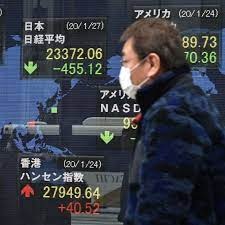
Japan, the world’s fourth-largest economy as of mid-2025, is grappling with a confluence of economic pressures that threaten its stability and energy security. From sluggish growth and surging bond yields to demographic decline and political upheaval, these challenges are amplifying the nation’s heavy reliance on imported energy. As a net importer of over 90% of its energy needs, any financial turbulence directly inflates costs for oil, natural gas, and coal—key pillars of Japan’s power generation. This article explores the latest financial indicators, the bond market’s volatility, employment trends, energy import dependencies, recent political shifts, investor priorities, and how U.S. President Donald Trump’s recent tariff reductions on Japanese autos could provide a lifeline.
Economic Headwinds: Growth Stagnates Amid Global RisksJapan’s economy is showing signs of strain in 2025, with revised second-quarter GDP growth at an annualized 2.2%, driven by consumer spending but overshadowed by external threats like U.S. tariffs.
Are you Paying High Taxes in New Jersey, New York, or California?
However, broader forecasts paint a gloomier picture: real GDP contracted by 0.2% annualized in early 2025, hampered by high inflation and a global slowdown.
Analysts project full-year 2025 GDP growth at around 1.1%, avoiding recession but moderated by overseas policy shifts and trade disruptions.
The Bank of Japan anticipates further moderation due to slowdowns in key trading partners.
Compounding these issues is Japan’s accelerating population decline, which shrank by over 900,000 people in 2024—the steepest drop on record.
This demographic crisis exacerbates labor shortages and dampens domestic demand, fueling long-term stagnation. By year’s end, Japan is expected to slip to the fifth-largest economy globally by nominal GDP.
Key challenges include sustaining a fragile recovery, reducing overreliance on China amid geopolitical tensions, and navigating U.S. protectionism.
Bond Market Turmoil: Yields Hit Multi-Decade Highs
The Japanese Government Bond (JGB) market is flashing warning signs, with yields surging amid policy normalization by the Bank of Japan. The benchmark 10-year JGB yield recently fell slightly to 1.55%, but it remains elevated after climbing to 1.60% in July—a 17-year high.
Longer-term bonds are even more volatile: the 20-year yield stands at 2.695% (up 80 basis points year-to-date), the 30-year at 3.29% (a multi-decade peak), and intraday highs reached 3.2% earlier in the year.
This spike reflects investor concerns over inflation reflation and potential rate hikes, which could unwind the yen carry trade and trigger global bond selloffs.
Higher yields increase borrowing costs for Japan’s massive public debt (over 250% of GDP), straining fiscal resources and indirectly raising energy import bills through a potentially weaker yen.
Employment Stability: A Bright Spot in the Storm
Amid economic woes, Japan’s labor market remains resilient. The unemployment rate held steady at around 2.5% in mid-2025, with projections for it to remain flat through 2026.
Employment rates dipped slightly to 62.4% in July but have improved overall by about 0.5 percentage points in the past year.
The OECD notes decelerating employment growth globally but highlights Japan’s low unemployment as a buffer against deeper recession.
However, this stability masks underlying issues like an aging workforce and population shrinkage, which could limit consumer spending and heighten vulnerability to energy price shocks.
Energy Imports: Heavy Dependence on Fossil Fuels
Japan’s energy security is precarious, with imports covering nearly all requirements due to limited domestic resources.
In 2024, crude oil imports averaged 124 million tons (down 7% year-over-year), making Japan the sixth-largest oil importer globally.
It remains the world’s largest LNG importer and third-largest coal importer after China and India.
Sources are concentrated: about 90% of crude oil comes from the Middle East, while LNG and coal are more diversified but still heavily reliant on imports (nearly 100% dependency).
In the electricity mix, gas accounts for 31%, coal 28%, and oil a smaller share, with low-carbon sources at 35%.
Forecasts assume crude oil import prices at $67/barrel for fiscal 2025, but volatility could spike costs.
The financial crisis amplifies these risks: a depreciating yen (exacerbated by low yields in the past) makes imports costlier, potentially adding billions to energy bills and stoking inflation. Political instability and global trade tensions further threaten supply chains.
Political Shakeup: Prime Minister Ishiba Resigns
Adding to uncertainty, Prime Minister Shigeru Ishiba resigned on September 7, 2025, following bruising election losses for the Liberal Democratic Party (LDP).
His departure, amid calls for accountability after the LDP’s failure to secure a lower house majority, ushers in policy paralysis at a critical juncture.
This marks Japan’s third prime minister in five years, highlighting chronic instability that could delay reforms in energy diversification and fiscal management.
Investor Perspectives: Seeking Resilience and ReflationInvestors eyeing Japan in 2025 are focusing on reflation opportunities amid policy shifts, but they’re wary of slowdown risks from Trump tariffs, China’s woes, and demographic drags.
Key watchpoints include inflation protection strategies, yen strength from potential rate hikes, and equity resilience (Nikkei up 8% locally despite volatility).
Foreign investors are driving the reflation trade, while locals remain cautious.
Broader concerns include the unwind of the $20 trillion yen carry trade, which could spike global yields and disrupt markets.
Optimists see Japan as a top non-U.S. pick for growth assets.
Trump’s Tariff Cut: A Boost for Japan’s Trade Balance
In a timely relief, President Trump signed an executive order on September 5, 2025, slashing U.S. tariffs on Japanese cars and parts from 27.5% to 15%, effective September 16.
This deal, part of a broader U.S.-Japan agreement, includes Japan’s commitment to $550 billion in U.S. investments.
For energy importers like Japan, this eases pressure on auto giants (Toyota, Honda, Nissan), bolstering exports and foreign exchange reserves to offset rising import costs.
It could stabilize the yen, indirectly curbing energy inflation and supporting a fragile recovery.
Conclusion: Navigating Uncertainty in Energy
2025 financial challenges—stagnant growth, bond volatility, and political flux—pose direct threats to its energy imports, potentially driving up costs and straining supplies. Yet, low unemployment, investor interest in reflation, and U.S. tariff relief offer glimmers of hope. As the nation pivots toward diversification (targeting 35-40% low-carbon by 2040), stakeholders must monitor global trade dynamics closely. For energy markets, Japan’s plight underscores the fragility of import-dependent economies in an era of geopolitical shifts. Buckle up, and we will be tracking to see how their slowdown impacts oil and LNG prices.
Avoid Paying Taxes in 2025
Crude Oil, LNG, Jet Fuel price quote
ENB Top News
ENB
Energy Dashboard
ENB Podcast
ENB Substack






